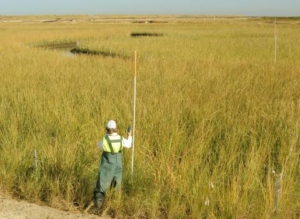Lorie Staver scans the green and golden marsh on a small stretch of land in Chesapeake Bay called Poplar Island.
It’s something she has done hundreds of times from her graduate student days to now, as an Assistant Research Scientist for the University of Maryland Center for Environmental Science’s Horn Point Laboratory.

Staver at Poplar Island
Staver is exhaustively monitoring the island, from the dirt below her feet to the vegetation that grows around her, as it transforms from a construction site to a wildlife habitat.
In the mid-1800s, Poplar Island was 1,100 acres. Over time, erosion ate away at its sandy coast, and by 1995, it was a disjointed landscape totaling 5 acres.
Today, Poplar Island is looking more like its old self due to an ongoing, multi-faceted restoration project. The State of Maryland partnered with the Army Corps of Engineers to restore the island using dredged material from the shipping channels in the main stem of the Chesapeake Bay approaching the Port of Baltimore.
With new marsh fields, higher elevation points, and a stone-based perimeter, the island has been built to better withstand future erosion. By 2040, they will build the island to 1,715 acres using 68 million cubic yards of material.
“By restoring island habitat that has been lost, we can help preserve populations of birds in the state of Maryland and at the same time provide a placement site for dredged material,” Staver said.
Years before its scheduled completion, Poplar Island has already become a home to more than 200 species of birds, including snowy egrets, osprey, and the American black duck, and more than 100 insect species. The island also serves as a nesting site for diamondback terrapins and safe harbor for the Bay’s fish and shellfish resources.
“You know the saying, ‘If you build it, they will come,’” Staver said. “It’s amazing how fast the wildlife showed up once the habitat was restored.”
Project Background
UMCES scientists, including Staver, Research Professor Jeffrey Cornwell and Professor Emeritus Court Stevenson, have been monitoring Poplar Island since 2003, shortly after the first marsh cell was planted and developed. UMCES works alongside Maryland Environmental Service on the ecosystem restoration project.
The UMCES scientists focus on vegetation and sediment characteristics on the island. 
“The goal is to establish the marshes as efficiently and cost effectively as possible, and to create the most sustainable marshes possible,” Staver said.
Their work involves monitoring marsh health and noting details, such as plant height, stem density, species distribution and diversity, and seedling density, to evaluate the development of the marshes. Staver started this work with Stevenson as a faculty research assistant.
Credit for this story goes to the News team at UMCES.
